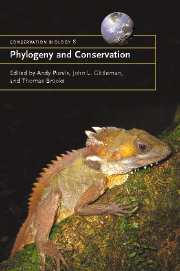Book contents
17 - Phylogenetic futures after the latest mass extinction
Published online by Cambridge University Press: 04 December 2009
Summary
INTRODUCTION
The Journal of Ecology and the Journal of Animal Ecology are two of the journals published by the British Ecological Society. In fact, the first is really a journal of plant ecology: it has the more general name simply because it came first and, at the time, most ecologists studied plants. Similarly, the general word biology typically only refers to the study of macroscopic plants and animals, whereas microbiology is the study of microscopic organisms. In fact, of course, it would be more appropriate to call these studies macrobiology and biology, respectively.
This is simply because, as is well known, most of life is microscopic. This is true in terms of both biomass and biodiversity. Macroscopic life jumps around and makes a lot of noise but, apart from morphological diversity, represents very little diversity in broader senses. This is visually evident from inspection of phylogenetic trees of life constructed from studies of small subunit (SSU) RNA genes, such as the one in Fig. 17.1, where macroscopic life only appears in a couple of tips. (I ignore fungi in this chapter.) Even in classification systems that give animals a special place, such as the Five Kingdoms (Margulis & Schwartz 1988) microscopic life still abounds: of the 33 animal phyla recognised by Margulis, 12 have microscopic members. A new animal phylum, Cycliophora, discovered more recently, is also microscopic (Funch & Kristensen 1995).
- Type
- Chapter
- Information
- Phylogeny and Conservation , pp. 387 - 399Publisher: Cambridge University PressPrint publication year: 2005
References
- 2
- Cited by



